“You’ve got to be kidding me,” I swore.
A clump of wet, sandy mud fell out of my sleeping bag and onto the ground through my open car door. I sat huddled on a makeshift bed in my Subaru while it poured rain outside with the car door cracked trying to clean off the mud I had just tracked in. In vain, of course. All I was doing was further exposing my bedding to the elements.
Night two of what was supposed to be a two week solo road trip, and already my sleeping bag has mud in it.
This, I thought as I slammed the car door shut, is why people don’t camp in the spring.
Late April, and all day it downpoured. I spent the morning hiking and between sweat, the humidity, a small waterfall, and the relentless rain, I was soaked to the bone. A shower in the state park bathroom, dinner under the tailgate of my car, mud at the campsite so thick it caked onto my shoes and apparently, somehow, into my car as well. I was damp and cold and even with the solar string lights and cozy pile of blankets (all damp from humidity or getting splashed by the Biblical rainfall any time I opened the door), even with the book I was highly invested in reading and the sweeping views from my campsite over the Wisconsin River I was simply not so sure I was having fun.
Still, I was faring better than the other solo traveller two campsites down.
Her first time out alone in her large van, the tires had planted themselves firmly in at least a few inches of mud. I’d gone over to help her earlier at her request, doing my best to explain that it was probably best to not slam on the gas, we’re only sinking the wheel more. To no avail. Her tires were now nearly half-sank into the mud. We left a message with the parks office asking for some help in the morning..
My car might not be stuck, but I’m sure she doesn’t have mud in her bed. Win some, lose some.
I romanticize the Midwest and learn a valuable lesson
At face value the purpose of a solo road trip throughout the southern Midwest is to have new regions to write about. I work as an outdoor/travel writer and if it weren’t for that, I probably wouldn’t have found myself sleeping in my car in a pile of damp and muddy blankets with string lights hanging above me as if it’s romantic.
But if I’m being honest the purpose of the solo road trip is to prove I still can.
Fresh out of college after a summer of guiding, I had driven around the Upper Peninsula and camped and paddled alone. I made friends with strangers and didn’t plan ahead. After that, I moved to a different continent to teach English for a year. When that fell apart and I lost my home and job due to the pandemic, I came back to the US. I met Andy, my now fiancé, and for the past four years all of those adventures I used to have alone we now have together. Which of course, is wonderful and more fun than alone.
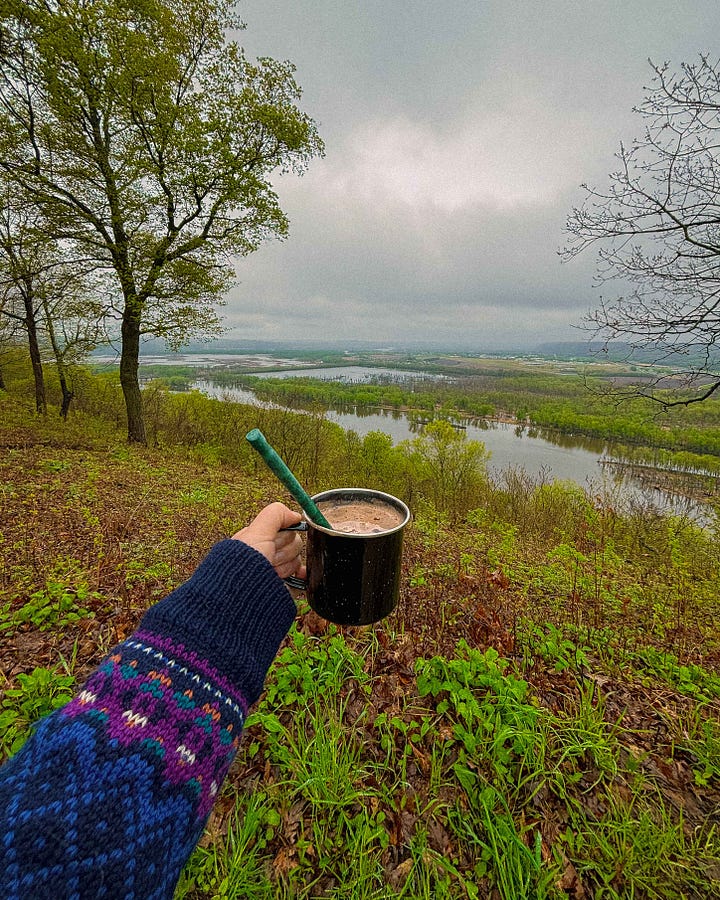
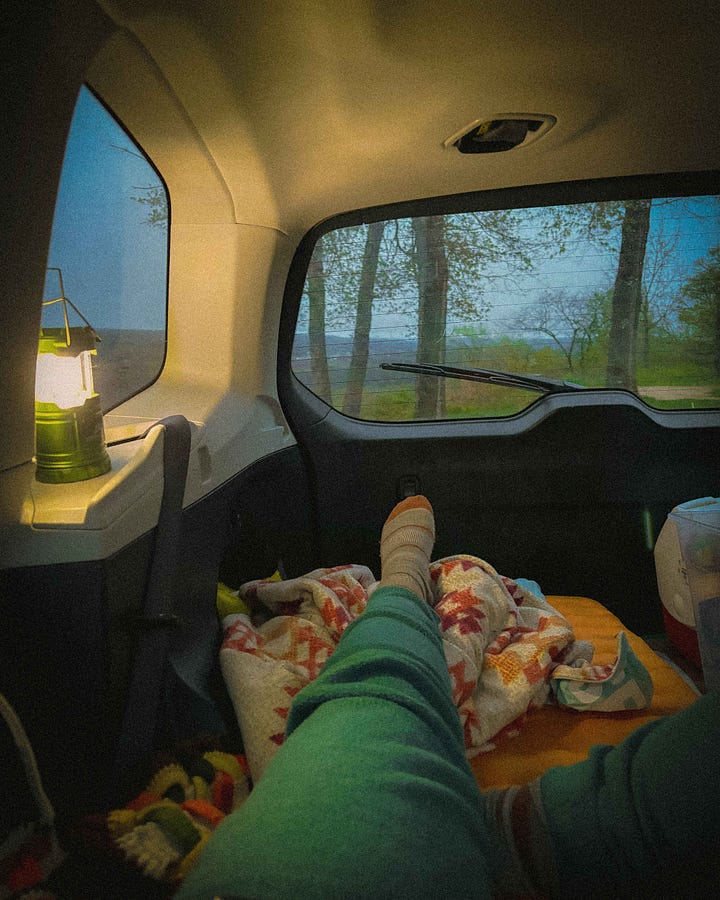
But looking back at me at 22 I can’t help but wonder if she’s braver than me at 28.
I wanted to prove to myself that I could still be like her.
Which is how I ended up curled up in a damp and dirty sleeping bag in the back of a Subaru. Of course, me at 22 probably wouldn’t have noticed the damp or the dirt. I’m getting soft, I think to myself, a little sad.
The rain is loud on the car roof and I stay up late reading until I start to dry out, fog lining the windows. The campground is empty except for me and the other solo woman, just a few sites down.
On that solo road trip six years ago I spent the first night alone in the tent wide awake. While I had made my dinner two men probably in their early thirties stopped by my campsite, beer in hand and warned me there was a bear in the area. I assured them I wasn’t too worried— the family down the campground with four kids was making hot dogs. I doubted the bear would be interested in me. They’d invited me to camp with them, to be safe. I politely declined, struck even then by the irony of the idea that I would be safer at a campsite with drunk strangers a decade older than me than a bear looking for food scraps.
That night, I laid awake in my tent for hours before I moved to the car to sleep and locked it.
I think about this while it rains, just me and another woman alone in the entire campground. Maybe I was never really braver back then. Maybe bravery is simply not letting fear stop you from doing the things you want to, especially if they’re things a man could do without ever being asked “is that safe”. Maybe that’s why I need to prove I can solo camp without Andy still— since I've been with him, no one has ever inquired about my safety in the woods. There is an unspoken assumption that he will take care of me, but I need to know I can take care of myself.
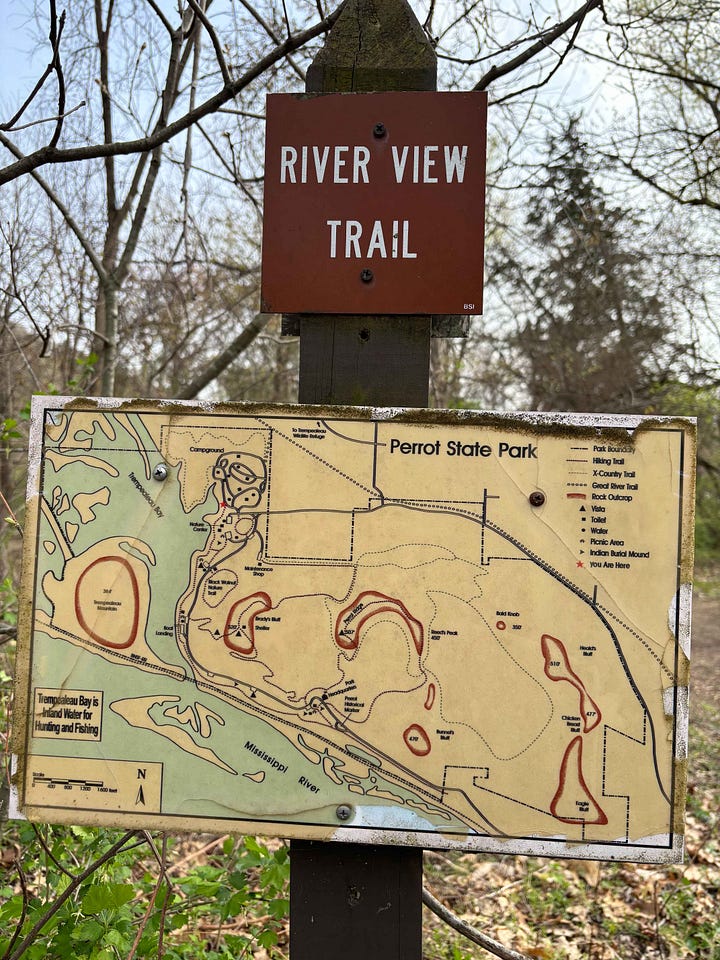
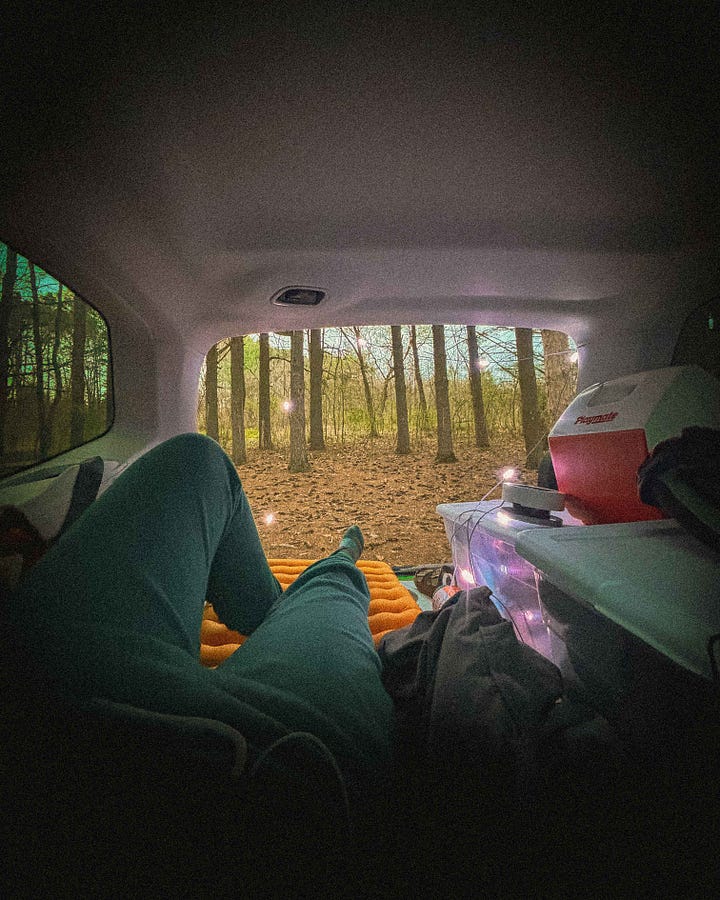
About the Mississippi
My muddy campsite with puddles of standing water sat on Wisconsin Ridge overlooking the confluence of the Wisconsin and Mississippi Rivers. I wanted to come here specifically, and planned a whole portion of my trip around this spot.
I left Lake Superior as it rained in the morning—gear all dry and clean—and drove down to Willow River State Park and walked to the waterfall before heading to Perrot State Park near La Crosse, Wisconsin and hiked up a ridge overlooking the Mississippi. Shockingly beautiful, really. A haul up the ridge, an interesting stone staircase with a sheer drop on either side and a shelter at the top, it reminded me a little of the Appalachian Trail—actually all of the Driftless Region reminds me a little of the Appalachians in part.
READ: Best Hiking on the Great River Road
The Driftless Region spans the southwestern corner of Wisconsin through southeastern Minnesota and northeastern Iowa around the Mississippi, Wisconsin and Iowa Rivers’ drainage basin. Driftless, because the region was passed over by the last round of glaciers and not subject to glacial drift. Basically in the last Ice Age, the glaciers carved out their own geography, bulldozing previous canyons and drainage patterns. The Driftless escaped, leaving ancient riverbeds and streams and the thousands of years of erosion intact.
What’s left today is intricate streams and rivers that have cut valleys and canyons and left bluffs with sweeping views high above rivers. Beneath the bluffs and valleys are springs of cold water and caves. In a few places, you can find the unique ecosystem of algific talus slopes that harbor pockets of boreal ecosystems. There are hidden waterfalls and rolling hills and sleepy towns– a quiet sort of beauty, a Lord of the Rings feel.
There’s history too.
Along the Mississippi and throughout the Driftless are hundreds of effigy mounds, built by Late Woodland Period (500-1000 CE) Indigenous Americans—mounds built in the shapes of animals, most often the bear and the bird. A lot of the mounds are perhaps seen in Effigy Mounds National Monument. Farther south, there’s another, different mound site:
Cahokia, the site of a prehistoric city larger than contemporary London in 1250 CE perhaps home to 20,000 in its heyday. Cahokia was a trading hub with a city center and developed farmlands and large, pyramid-like mounds, home to politically-motivated killings and other evidence of some sort of developed government and power-structure.
READ: Cahokia: Ancient America's Great City on the Mississippi
It’s so often casually remarked that America is uncultured because our history begins in 1776 while in Europe things are so much older, but that’s just not true. America also had cities and culture long before Europeans came here. And it is very interesting to read about, learn about, and experience.
And so for its hiking, for its history, and for its geology I find myself extremely taken with the Mississippi and the Driftless.
a moment just for you
It’s a beautiful place but when I wake up in the morning I am ready to be rid of it.
I am done with the damp and cannot find the fog over the valley or the bright spring greens to be beautiful. A hidden cave and waterfall in a state park is lovely, sure, but my socks are wet.
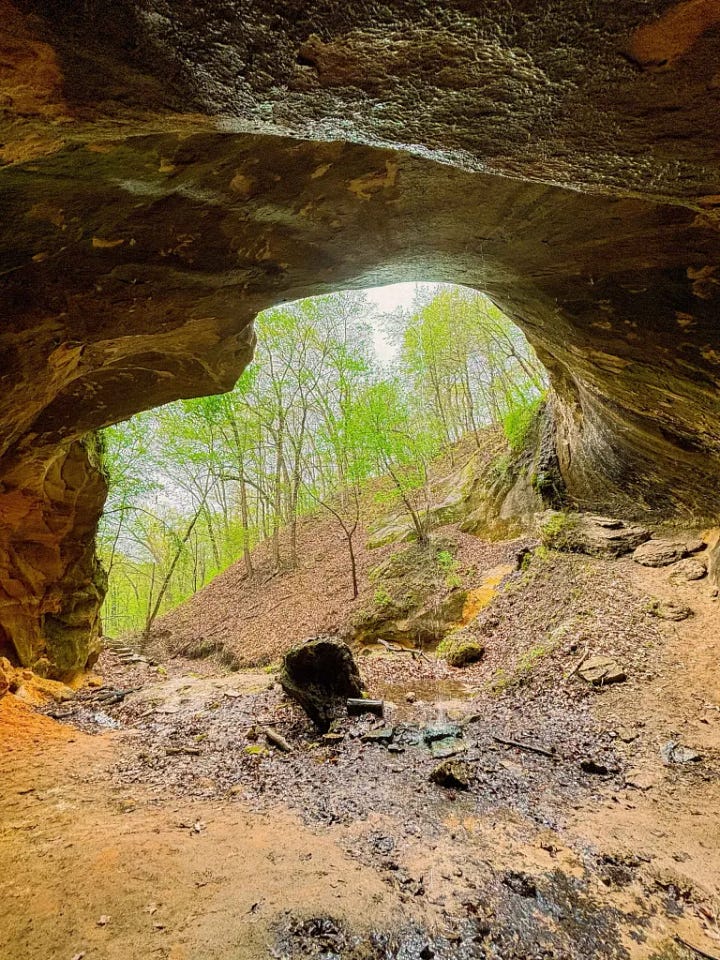
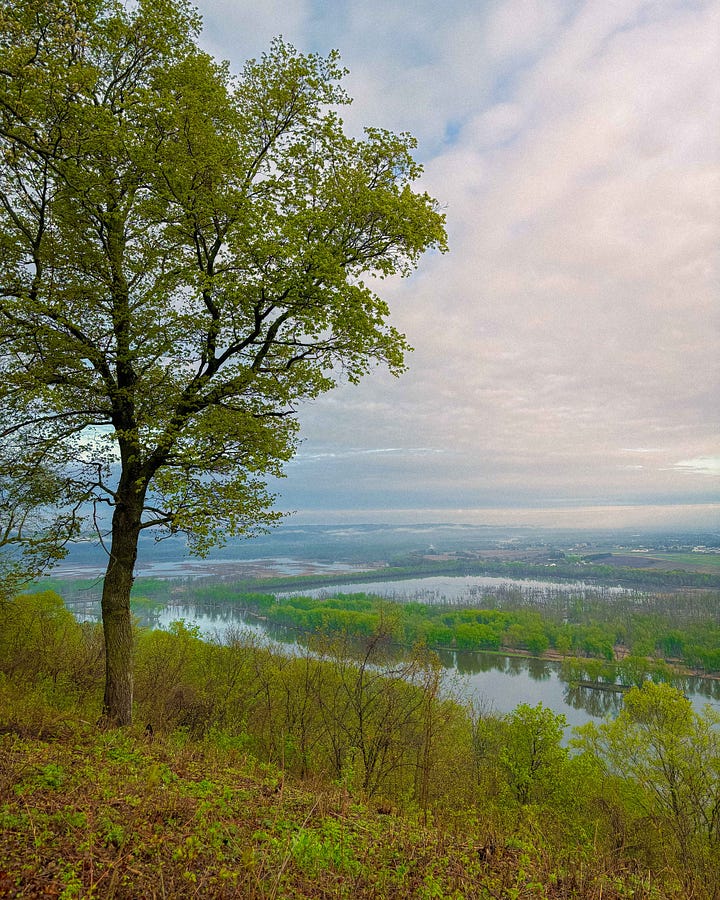
Still, as I packed up and the trees dripped dew and rain all heavy with spring. Sound of birdsong, and it was like I’d forgotten how loud the summer is in the time I’d been entrenched in the stillness of winter. The earth smelled like life instead of frost.
Spring is a full sensory experience in that way. Wet socks, loud birds. My shoes squelch. This is why people don’t camp in the spring, I hiss to myself. A robin lands on the picnic table, and I smile and say hello.
Then I drive miles and miles south out of the rain, into the sun, a podcast, an audiobook, an album and it’s raining again then it’s storming and suddenly it feels almost like I’m down south, pulling into a campsite where it isn’t spring at all but full summer.
More rain and thick green leaves and I change from my fleece pants into shorts at a gas station in southern Illinois. I drive into the wilderness in a place where it feels like there shouldn’t be any. I find a drive up campsite on a ridge at five pm or so, a campsite mostly full of retired folks in nice RVs and me, all alone, a pink raincoat and a pair of shorts.
It pours but it’s less muddy here, though humid, and I mutter about it, wondering what exactly I think I’m proving to myself. I change a damp base layer for a dry one, bitterly ask myself if I’m sick of my own company yet, only on day three.
Truth is, I am. I’m an extrovert, even though that feels a little passé for a writer to admit. I like people. I’m not a writer because I’m introspective; I’m a writer because I simply can’t shut the fuck up1.
So I go for a walk, alone in the rain.
I walk through what feels to me like a jungle, big-leafed plants and salamanders and box turtles everywhere to a cliff in the woods. Looking at grey and red columns of sandstone, I find a spot to sit on the slick rock high up above the forest below. Birds fly in and out of the woods chasing each other's tails and the rain breaks for a moment for the sun but then comes back, harder than before and it’s quiet here; only me. Quiet, but also not really.
There are so many birds, and they’re loud.
The rock I’m sitting on is 320 million years old, an ancient shoreline where rivers deposited sand in layers as they met the sea, uplifted and eroded away for the next million or so years. Give or take.
And the weather is utter crap, truly. It’s so muggy I feel like I’m breathing in water, but here I am all alone in a beautiful place. And when you’re alone in a beautiful place, it’s hard not to feel like maybe that moment exists just for you, a special piece of time carved out for you to be a part of the world, to witness it. And probably that’s not true, but I think it’s okay to feel important sometimes; it’s okay to feel like you deserve those moments.
Thanks for reading! This is part 1/2 of my solo midwest road trip fiasco from last year! stay tuned for more soon, or sign up below to never miss an update:
solo road trip FAQs:
Q: Isn’t that dangerous?
No more dangerous than anything else. Check out my guide to solo female road trip travel and more on the safety question here.
Q: What did you pack/how did you build out your car?
Great question! Very cheaply, and with just a few simple modifications. You can check out more about the logistics of solo car camping here.
Q: What did you eat and how did you plan your route?
Check out road trip packing, organization, and meal planning tips and ideas here.
sorry grandma, it was for emphasis

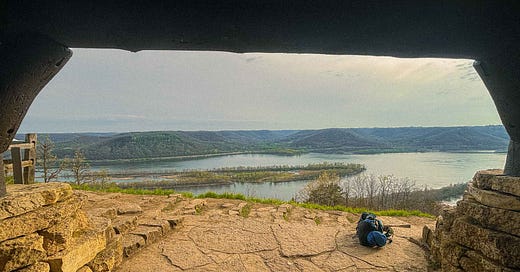




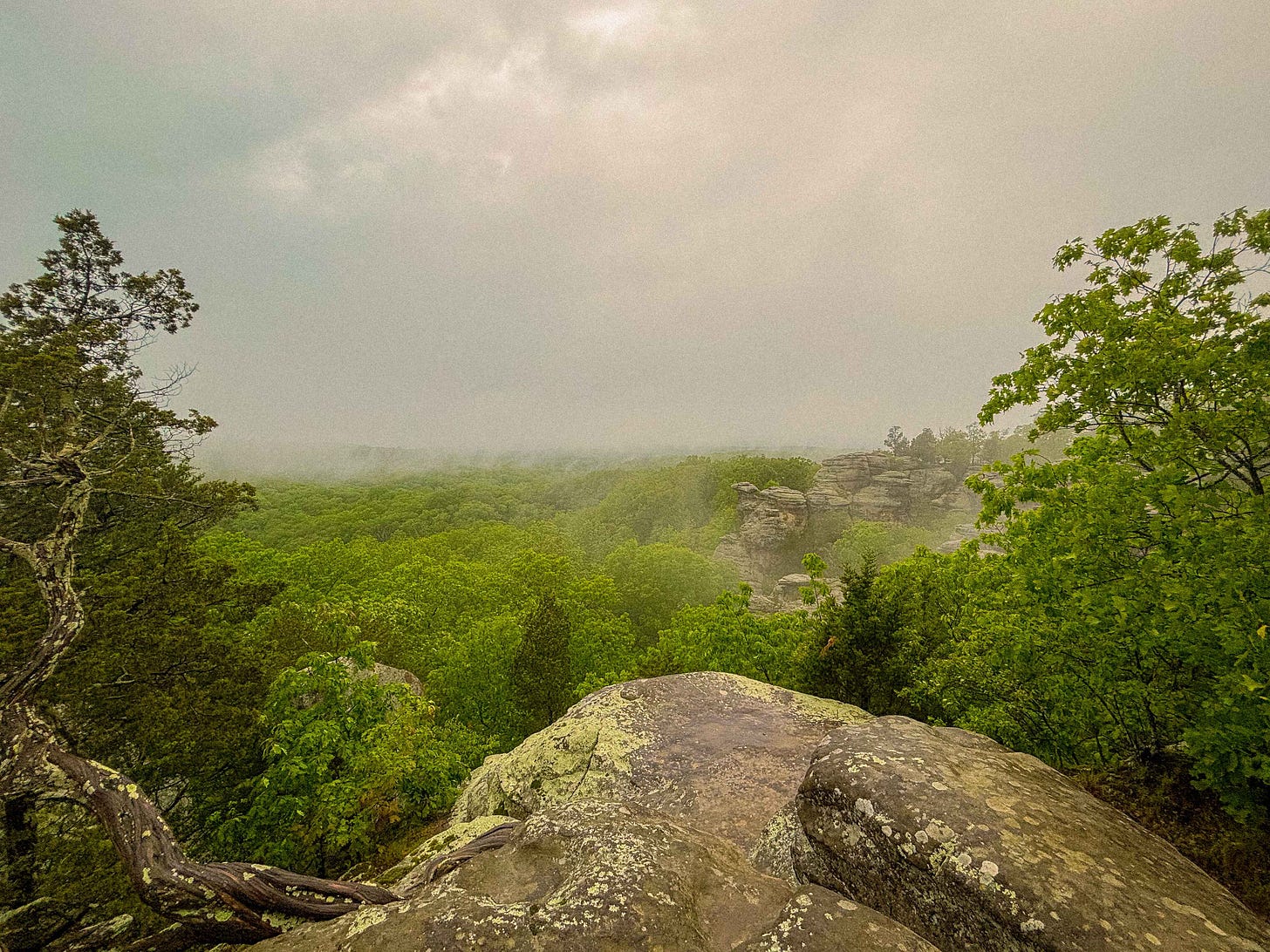
How am I this many years old, and have never heard about the Cahokia, having more or less grown up in Minnesota. Our American history classes seriously fail us. Just tagged it on my public library app to read next.
Really good read! Glad I'm not the only one who goes from my tent to my car when I can't sleep. Also you made a great point about America's history. More people should read up on the ingenious cultures that thrived well before the arrival of European settlers.